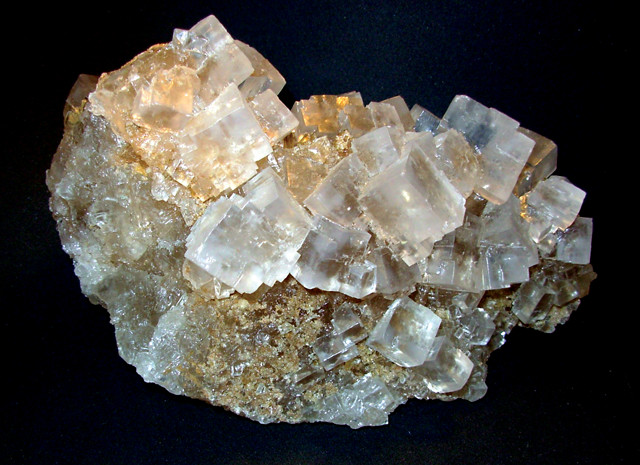
by USGS Mineral Commodities Team Thursday, June 14, 2018
Dennis S. Kostick, a mineral commodity specialist for the U.S. Geological Survey, compiled the following information on salt.

The mineralogical name for salt is halite. Credit: U.S. Geological Survey
Salt, also known as sodium chloride, is a compound that contains 39.34 percent sodium and 60.66 percent chlorine by weight. Sodium is a silver-colored metal that is so unstable that it reacts violently in the presence of water; chlorine is a greenish-colored gas that is dangerous and may be lethal. Yet the combination of these two elements forms a mineral that is essential to life itself — and is perhaps the only mineral that is used by every human.
Salt’s economic and cultural importance has diminished over time, yet it has had a profound influence on history. Populations have migrated across deserts and over mountains in search of salt, cities have been built near salt sources, and wars have been fought to obtain or to protect salt supplies. Although salt once was considered as precious as gold because of its scarcity, today more than 110 countries produce some type of salt.
In the United States, the world’s second-leading salt-producing nation, 29 companies operate 69 salt plants and produced 47.3 million metric tons of salt in 2008. The four types of salt produced in the United States are classified by their method of recovery.
Rock salt is mined from underground halite deposits that are found as either horizontal bedded formations such as those in New York and Ohio, or as salt domes such as those located along the Gulf Coast. In some arid areas of the West, rock salt can be found near the surface and extracted using open pit mining.
Solar salt is obtained from seawater along coastal margins, such as in California, and from landlocked bodies of natural saline water like the Great Salt Lake in Utah and artificial brines, where it is a byproduct of potash mining, such as in New Mexico. Salt production uses the wind and sun to evaporate the water, leaving behind relatively pure crystals of salt. Solar salt production is restricted to areas of the world that have high evaporation rates and low precipitation. Sea salt, which is popular in food, is packaged solar salt.
Salt brine is obtained by solution mining in underground halite bedded deposits or from salt domes. Water is injected in drilled wells to dissolve the salt, leaving the insoluble minerals behind while forming underground caverns. The saturated solution of salt is pumped to the surface and treated to remove any soluble impurities. The majority of salt brine is produced for use in chlor-alkali manufacturing.
Vacuum pan salt is not mined but is a type of salt produced using mechanical evaporation technology. Although any of the other three types of salt may be dissolved or used to make vacuum pan salt, virtually all domestic vacuum pan salt is obtained from solution mining in underground salt formations.
Although there are about 14,000 direct and indirect uses of salt, most people associate salt with its use in food as a flavor enhancer and its use as a road deicing agent. However, salt’s largest use is in manufacturing chlorine and sodium hydroxide, which in turn are used to make polyvinyl chloride (PVC) plastic, nylon, bulletproof glass, plastic food wrap and countless other everyday household products. Without salt, we would not have many of the common items we take for granted today.
For more information on salt and other mineral resources, visit minerals.usgs.gov/minerals.
World salt production by 113 nations in 2008 was estimated at 258 million metric tons.
China leads the world in salt production.
The National Academy of Sciences recommends a daily sodium intake level, mainly from salt, of no less than 500 milligrams but no more than 2,300 milligrams, which is equal to about one teaspoon (or about 6,200 milligrams) of sodium chloride. However, the average adult consumes about 3,500 milligrams of sodium daily. About 80 percent of a person’s intake of salt is from processed foods.
The mineralogical name for salt is halite, from the Greek word hals, meaning salt.
The world “salary” is derived from the Latin word sal for salt. Early Roman soldiers were paid, in part, with salt rations.
The saying “not worth his salt” originated in ancient Greece and signified that a slave wasn’t strong and healthy.
Russian cosmonauts on the International Space Station still greet newly arrived astronauts with bread and salt, a gesture of hospitality.
Cannibalism reportedly has been attributed to humankind’s innate hunger for salt. The practice originated in remote salt-deprived areas, where the people found that the flesh and blood of others from salt-rich areas satiated their physiological need for salt.
Salt is not just a flavor enhancer, but also an important preservative in foods.
The American frontiersman Daniel Boone and his sons had a salt-making operation in Blue Licks, Ky.
© 2008-2021. All rights reserved. Any copying, redistribution or retransmission of any of the contents of this service without the expressed written permission of the American Geosciences Institute is expressly prohibited. Click here for all copyright requests.